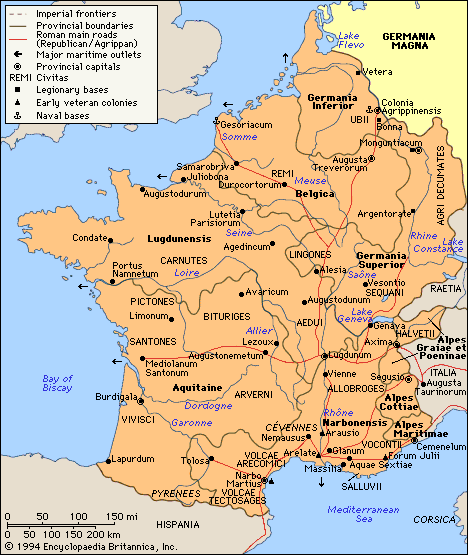
Gaul
The region inhabited by the ancient Gauls, comprising modern-day France and parts of Belgium, western Germany, and northern Italy. A Celtic race, the Gauls lived in an agricultural society divided into several tribes ruled by a landed class.
By the 5th century BC the Gauls had migrated south from the Rhine River valley to the Mediterranean coast. By the middle of the 4th century BC various Gallic tribes had established themselves across northern Italy from Milan to the Adriatic coast. The region of Italy occupied by the Gauls was called Cisalpine Gaul ("Gaul this side of the Alps") by the Romans. In 390 BC the Gauls seized and plundered the city of Rome. This humiliation helped to inspire the Romans' drive to conquer Gaul. The Cisalpine Gauls pushed into central Italy by 284. In a series of confrontations, the Romans defeated the tribe of the Insubres, took Milan, and established colonies in a buffer zone. In the Second Punic War, Hannibal of Carthage made an alliance with the Gallic Cenomani against the Romans; the Romans prevailed, however, and by 181 Rome had subjugated and colonized Cisalpine Gaul. 
By the 2nd century BC, when the Romans extended their territory across the Alps into the south of France, they already controlled most of the commerce in that part of the Mediterranean. An alliance with the Aedui against the Allobroges and the Arverni brought the Romans control of the Rhône River valley after 120 BC. The Roman colony of Narbo Martius (Narbonne) was founded on the coast in 118, and the southern province became known as Gallia Narbonensis. An invasion by Germanic Cimbri and Teutones was defeated by Marius in 102, but 50 years later a new wave of invasions into Gaul, by the Helvetii from Switzerland and the Suevi from Germany, triggered Roman conquest of the rest of Gaul by Julius Caesar in 58-50 BC.
During 53-50 Caesar was engaged in suppressing a Gallic revolt led by Vercingetorix. He treated the Gauls generously, leaving their cities with a significant measure of autonomy, and thus secured the allegiance of Gallic soldiers in his civil wars against Pompey in 49-45. A former religious centre of Gallic society, Lugdunum (Lyon) became the capital of Roman Gaul. The country was divided into four provinces: Narbonensis, Aquitania to the west and south of the Loire, Celtica (or Lugdunensis) in central France between the Loire and the Seine, and Belgica in the north and east. The Romans built towns and roads throughout Gaul and taxed the old Gallic landowning class while promoting the development of a middle class of merchants and tradesmen. The emperor Tiberius was obliged to suppress a rebellion of the nobles in 21 AD, and the assimilation of the Gallic aristocracy was secured when the emperor Claudius (41-54 AD) made them eligible for seats in the Roman Senate and appointed them to governing posts in Gaul.
The next two centuries were marked by occasional revolts, by increasingly frequent invasions of Germanic tribes, against whom a line of limes, or fortifications, was erected from the middle Rhine to the upper Danube, and by the introduction of Christianity early in the 2nd century. During the reign of the emperor Marcus Aurelius (161-180), Germanic invaders crossed the limes. Frontier legions rebelled along the Rhine, spurring the civil wars that followed the death of the emperor Commodus in 192. An economic recession, marked by inflation and rising prices, hurt the towns and the small farmers.
In 260 Gaul, Spain, and Britain formed an independent Gallic empire, governed from Trier. The emperor Aurelian reclaimed Gaul for Rome in 273, but Germanic tribes devastated the country as far as Spain. Under Diocletian and his successors, reforms in defense and administration were instituted, but Gaul became a centre of the unrest that was fragmenting the empire. In the middle of the 4th century the tide of invasions swelled. By the 5th century the Visigoths had taken Aquitania, the Franks ruled Belgica, and the Burgundians dominated the Rhine. By the time the kingdom of the Frankish Merovingians arose, in the early 6th century, the Romans had lost control of Gaul.
In the end, Gaul proved to be an important repository of Roman culture. Gallic writers long kept the classical Roman literary tradition alive. Many of the amphitheatres, aqueducts, and other Roman works built in Gaul still stand. (Encyclopedia Britannica)